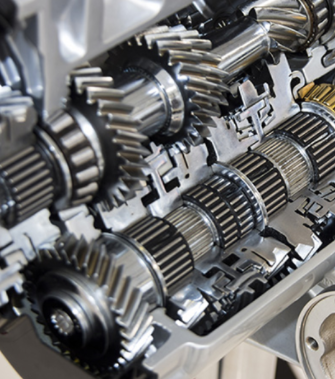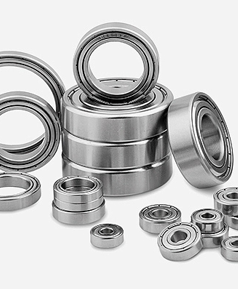The chassis is the support of construction machinery, which can make the overall unit run in the specified direction at the speed and traction required for operation. According to the characteristics of the traveling system, there are 2 main types of construction machinery chassis: 1.Wheeled chassis, including transmission system, braking system, steering system, traveling system. 2. Tracked chassis, including transmission system, steering system(incl. braking), traveling system, rotary support device(load carrying) Transmission System of Construction Machinery Chassis: The transmission components between the power unit and the driving wheel of construction machinery are collectively referred to as the transmission system. The transmission system is divided into mechanical transmission, hydraulic mechanical transmission, hydraulic transmission and electric transmission. The three main components of transmission system: Gearbox, Differential, Wheel Drive. Gearbox Dual-clutch AT Popular bearing types used: Tapered Roller Bearing Cylindrical Roller Bearing Needle Roller and Cage Assembly 2. AT with hydraulic torque converter Popular bearing types used: Needle Roller and Cage Assembly One-way Clutch Needle Roller Bearing Thrust Needle Roller and Cage Assembly Deep Groove Ball Bearing HK Series Needle Roller Bearing 3. AT with continuously variable transmission Popular bearing types used: Needle Roller and Cage Assembly Tapered Roller Bearing Cylindrical Roller Bearing Deep…
Difference between high-speed and low-speed bearings Many people may misunderstand it, it’s not that the rotation speed of the bearing itself, but its linear speed. Many low speed bearings can reach tens of thousands of revolutions per minute, on the other hand, for some high-speed bearings, the data of rotations per minute maybe only just a few hundred. There are also some other differences between the two. Generally, low-speed bearings have a rougher appearance, and the joints between parts are looser. To ensure its accuracy, the precision of high-speed bearing is generally very smooth on the surface, and the distance between the inner ring and outer ring is minimal, the accuracy is much higher. Many high-speed bearings are also super-precision bearings. It normally use special high speed grease. In terms of material, there is also a slightly difference between high-speed bearing and low-speed bearing. High speed bearings are generally made of very high hardness steel, which can withstand the pressure caused by excessively high speeds. If it’s low, some common materials are used, the requirements for hardness and durability of the material are relatively reduced. What to do if the high-speed bearing is overloaded and hot? 1) In the case…
When bearings are 100% inspected with all dimensions on approved drawings based on GB or ISO standard, we confirm bearings are qualified. Here we would like to share you with a case: One day we received an urgent request from our customer, that they asked us to deliver one SL bearing (full complement cylindrical roller bearing) to them in short time, reason was that the bearings delivered from their current supplier were rejected by their end user. The problem was the flatness of the end face of outer ring. End user inspected the flatness of the end face of outer ring by ZEISS Coordinate Measuring Machine, result was 0.14mm, thus bearings were rejected due to too big flatness 0.14mm. All other parameters are qualified based on GB/ISO standard. For us such problem is the first time to hear, so what is the flatness of the end face of outer ring? See below sketch: This parameter is generally marked on assembly drawing or not? See below sketch: We go further to analyze this issue, following facts were found: There is no GB/ISO standard of the parameter “flatness of end face of outer ring” for any kinds of bearings, so on assembly…
The type of machinery is different, the service conditions of the bearings will be different, and the performance requirements are also different. Generally speaking, there are more than two bearings that would be used on a shaft. In order to facilitate axial positioning, most of the bearings are used as fixed-end bearings, and the rest are used as floating-end bearings. The following table lists the choice of fixed end and floating end bearing structure.
Bearing Selection Guide The types, structures, and sizes of rolling bearings are diverse. In order to make the mechanical device play the expected performance, it is very important to choose the most suitable bearing. To select a bearing, many factors need to be analyzed. The general sequence is as follows: (1) Understand the operating conditions of mechanical devices and bearings, etc. (2) Clear requirements for bearings (3) Select the type of bearing (4) Select the bearing configuration (5) Select bearing size (6) Select bearing specifications (7) Installation method of selected bearing The location of the bearing, the operating conditions, and the environmental conditions are the prerequisites for choosing a suitable bearing. For this, it is necessary to obtain the following data and information: (1) Function and structure of the mechanical device (2) Where to use the bearing (3) Bearing load (size, direction) (4) Rotation speed (5) Vibration and shock (6) Bearing temperature (ambient temperature, temperature rise) (7) Ambient atmosphere (corrosive, clean, lubricating) How to select the bearing type for your machine? When selecting a bearing type, it is important to fully understand the operating conditions of the bearing. The following table lists the main analysis items:
Have you ever noticed the types of cage guidance of your bearings? Basically, there are 3 types: outer-ring-rib guidance, inner-ring-rib guidance, and rolling-element guidance. Unfortunately, big part of Chinese factories, including big brands, don’t put their eyes on cage guidance. They believe various types of cage guidance are interchangeable. You may get NU2310 with MA brass cage with outer-ring-rib guidance, e犀利士 ven though you order “NU2310M” with clear requirement of rolling-element guidance. In some cases, it may lead to a serious claim. All these 3 types of cage guidance probably appear in various types of bearings, with performance reasons, bearing design reasons and manufacturing reasons. Attention should be paid to the different performances of different types of cage guidance. The performance difference of these 3 types of cage guidance is mainly reflected in the speed performance under different lubrication conditions. During our research on cage guidance, we got to know something interesting as extra: 1. Brass cage is widely used in high-speed application. 2. There are 4 kinds of gaps between components: radial clearance (Gr), roller gap (△), cage guidance gap (Cr), cage axial gap (Ca), respectively. These gaps are defined as the maximum possible displacements between relative components in…
Full complement cylindrical roller bearings are capable of carrying higher radial loads than bearings that utilize a cage and roller design.
There are many types of bearing materials, among which stainless steel is probably one of the most commonly used bearing materials. Compared with ordinary bearing steel (Chrome steel GCr15/100 Cr6/SUJ2), stainless steel bearing not only have obvious advantages in material, but also much strict in process and precision control than ordinary bearing. It is more stable, has low noise and stronger anti-rust and anti-corrosion properties, it can be used in the condition of -60℃-+300℃with proper lubricant and shields 1. Excellent corrosion resistance: with strong corrosion resistance, stainless steel bearing is not easy to rust. And it will not react easily with water or liquid, can be washed with water. 2. Compared with steel material, stainless steel bearing is clean and has longer operating life. 3. High heat resistance can be operated in high temperature range from 180-1000 °F, therefore it can be adapted to all kinds of weather conditions, even if it’s very hot, we can cool it down with water. Stainless Steel Bearing includes SS440 Stainless Steel Bearing (Generally inner/outer ring/balls and rollers is SS440, cage is SS304): It is a kind of high-strength cutting tool steel with slightly higher carbon content. It can obtain higher yield strength after…
Full ceramic bearings have the characteristics of magnetoelectric insulation, wear resistance, corrosion resistance, oil-free self-lubrication, high temperature and cold resistance, which can be used in extremely harsh environment and special working conditions. Material ZrO2 has perfect properties such like suitable for low and high temperatures, high load capacity, corrosion resistance, nonmagnetic insultated and self-lubrication. Thus it suits for the specific applications which are not available for bearing steel and hybrid construction ceramic bearing materials. ZrO2 full ceramic bearings use zirconia (ZrO2) material for inner/outer rings as well as balls/rollers, retainer material is PTFE as standard, glass fiber reinforced nylon 66(PA66-25), PEEK, PI, SUS316, CU are also used as ceramic bearing retainers.Hybrid ceramic ZrO2 bearings use ceramic ZrO2 balls/rollers (weigh up to 40% less than steel balls/ rollers, depending on size, the lighter ball/roller allows the bearing to spin faster, use less energy to maintain its speed) and steel inner/outer rings(Normally chrome steel GCr15 or stainless steel AISI440). Anticorrosion properties of ZrO2 bearing Application: Food conveyor, Non-magnetic and insulation condition, Dust condition, Vacuum condition, High-temperature condition, Clean condition, Corrosive condition, Food industry, Linear guideway, etc.









